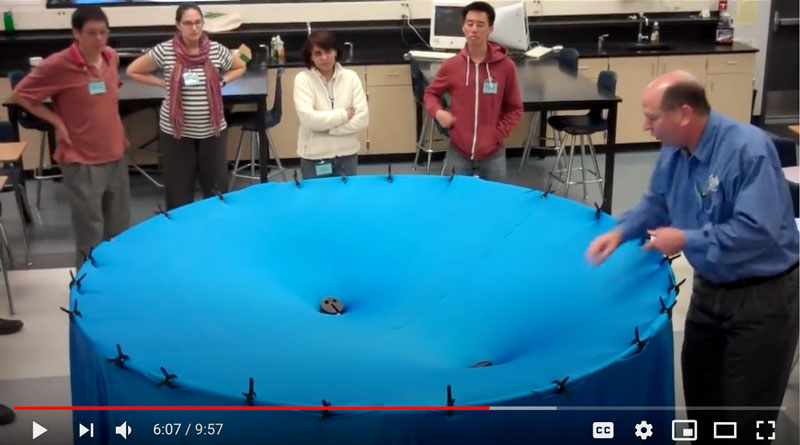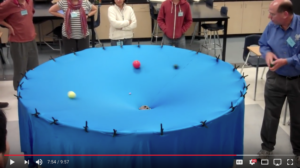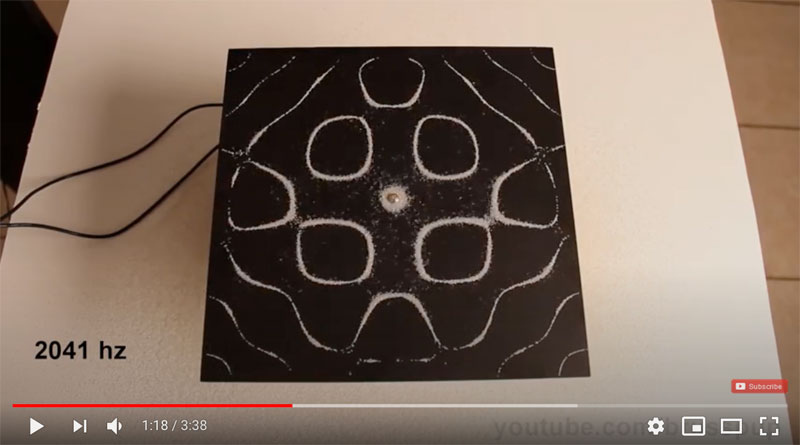Visualizations > Online Video > Classroom physics
Gravity Visualized – lycra (spandex) gravity well

Dan Burns’ “rubber sheet” model and similar visualizations of so-called gravity wells [1][2] are useful; but, like all analogies, such demonstrations have limitations – other than what he pointed out in the demonstration itself. Taken too literally, these illustrations can be misleading in mapping higher dimensional landscapes (geometries) to our everyday 3D (three dimensional Euclidean) space. (Certainly that was my experience.)

In the case of a black hole, an embedding diagram represents a 2D slice at some instant of time of (4D) spacetime. Donald Marolf’s 1998 paper “Spacetime Embedding Diagrams for Black Holes” [3], for example, notes these caveats:
[The funnel-like diagram] shows how the equatorial plane of a black hole would be curved if, instead of lying in the black hole spacetime, it were part of familiar flat Euclidean three space. Mathematically, this picture is said to represent an embedding of this plane into three dimensional Euclidean space.
[It] can be useful for explaining certain geometrical features, such as the fact that circles drawn around the equator of the black hole barely change in size as they are pushed inward or outward near the horizon [bottom of funnel]. However, since they refer only to space at a single instant of time, such diagrams do not describe the most important parts of black hole physics having to do with the spacetime structure of the geometry.
In addition, such pictures can be misleading for the uninitiated. For example, since the bottom of the funnel in fig. 1 is the black hole horizon, students may be tempted to believe that the horizon represents a real boundary of the spacetime. Another problem is that many students believe they can see the gravitational attraction of the black hole in fig. 1 by visualizing the path of a ball ‘tossed onto the funnel.’ Technically speaking however, there is no direct connection between fig. 1 and the attraction of a black hole …
Regarding the degree of curvature, as noted in the Q&A for Science Asylum’s YouTube “The REAL source of Gravity” video: “for gravity around the Earth (or any other planet-sized mass), space curvature is completely insignificant. It’s only the time that matters.” (Cf. Time correction in GPS systems.)
Notes
[1] A Google search on “embedding diagram” or “visualize spacetime” will find many images and PDF papers on the topic.
• Scientific American > “Make a Black Hole” by Science Buddies, Ben Finio (December 7, 2017).
• YouTube > Arbor Scientific > “Gravity Well” (Mar 28, 2018) – The gravity well is an exciting piece of apparatus which allows students to visualize the attraction of massive objects due to gravity.
• Wolfram > “Schwarzschild Space-Time Embedding Diagram.”
[2] As typically illustrated in Wiki’s article “Gravitational potential.”
For “Gravity well,” Wiki redirects to “Gravitational potential.” And “Embedding diagram” redirects to “Introduction to general relativity.”
Introduction to general relativity (redirect from Embedding diagram): curved surfaces are a generalization of ordinary plane surfaces. Embedding Diagrams are used to illustrate curved spacetime in educational contexts.
[3] arxiv > “Spacetime Embedding Diagrams for Black Holes” by Donald Marolf, Physics Department, Syracuse University, Syracuse, New York (June, 1998).
Standing Waves, Oscillators, Resonance Mode Shapes
• YouTube > “AP Physics 1: Waves 10: Resonance and Standing Waves on a String” (Dec 30, 2012).
• YouTube > James Dann > “Standing Waves Part I: Demonstration” (Aug 12, 2010) – Demonstration of standing waves on a string. How the standing waves are generated, harmonics and more is explained here.
• YouTube > Penn State U (Dan Russell) > “Mode Shapes for Multiple Degree-of-Freedom Oscillators” (Sep 20, 2012).
Whiffle baseballs and rubber bands are used to create a mass-spring system with 1, 2, 3, and 4 degrees-of-freedom. Each system is driven at its resonance frequencies, and the natural modes of vibration are demonstrated. The number of masses (different discrete objects undergoing displacement from equilibrium) determines the number of natural frequencies and mode shapes. As the number of degrees-of-freedom increases, the mode shapes begin looking like the mode shapes for a vibrating string fixed at both ends.
• YouTube > Penn State U (Dan Russell) > “Coupled Pendulum (minus the bagpipe music)” (Nov 8, 2014).
Two pendulums of equal length and connected by a soft spring, comprise a 2-degree-of-freedom system, with two natural modes of vibration. However, a special set of initial conditions (one mass released from rest at its equilibrium position while the other mass released from a displaced position) results in a coupled motion in which energy and amplitude are traded back and forth between the two pendulums.
• YouTube > “Amazing Resonance Experiment!” (Jun 6, 2013).

Particle detectors
• Symmetry Magazine > “How to build your own particle detector” by Sarah Charley (January 20, 2015) – Make a cloud chamber and watch fundamental particles zip through your living room!
The Continuously Sensitive Diffusion Cloud Chamber is one such detector. Originally developed at UC Berkeley in 1938, this type of detector uses evaporated alcohol to make a ‘cloud’ that is extremely sensitive to passing particles.
- Alpha particles spat out of [naturally occurring] atmospheric radon atoms are bulky and low-energy, so they leave short, fat tracks.
- Because they are so massive, muons bludgeon their way through the air and leave clean, straight tracks.
- Electrons and positrons are light particles and bounce around when they hit air molecules, leaving zig-zags and curly-cues.
- If your track suddenly forks, you are seeing physics [particle decay] in action!
• YouTube > US LHC (Filmed in CERN’s S’Cool Lab) > “How to build a Cloud Chamber” (January 20, 2015).
There are some other YouTube videos on making a cloud chamber. This is one of the simplest designs:
• YouTube > “Cloud chamber in five minutes” (July 26, 2017) – Quick and easy way to build your own diffusion cloud chamber. No dry ice is required. There is no need for too much alcohol, just enough for the sponge to absorb. Turn the compressed air bottle upside down and blow the cold liquid in the center of the tin can for about 5 to 7 seconds.
